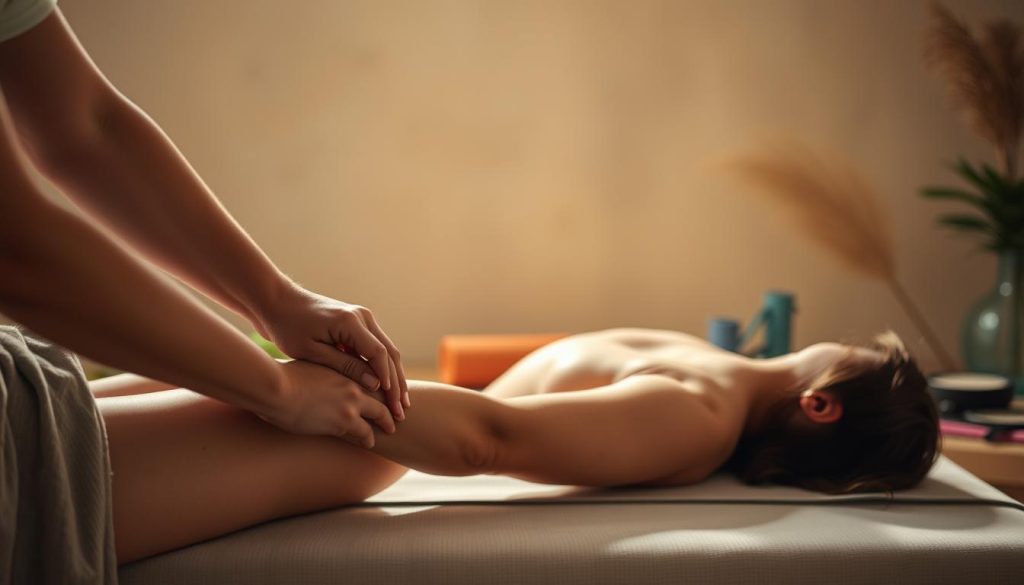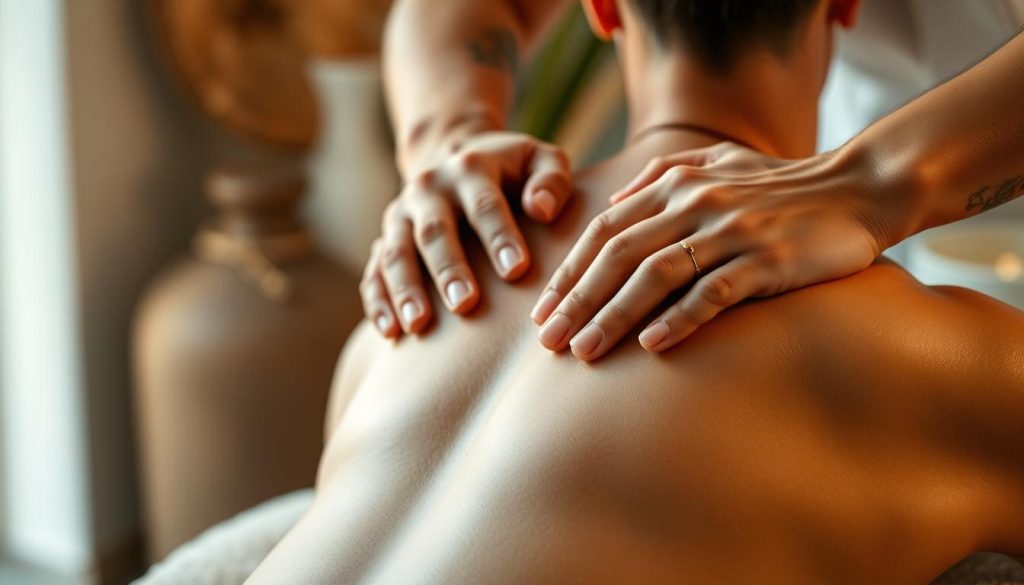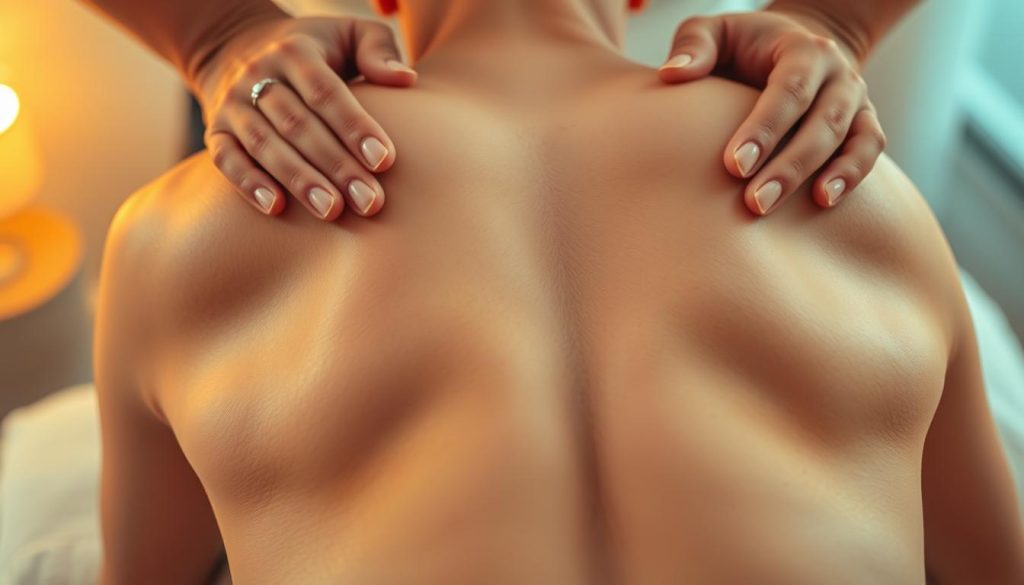Ever wondered why your body feels tender following a deep tissue session? That slight soreness is actually a sign your muscles are responding to therapy. Just like post-workout stiffness, this discomfort means your body is healing.
Deep tissue techniques target tight knots, releasing tension but sometimes causing temporary tenderness. The good news? With the right approach, you can minimize discomfort while maximizing the benefits of your session.
Gentler styles, like Swedish massage, often leave you feeling relaxed without much soreness. However, deeper work may require extra care. Hydration, light movement, and proper recovery techniques help your muscles adapt faster.
Key Takeaways
- Temporary soreness is normal and part of the healing process.
- Deep tissue techniques may cause more discomfort than lighter therapies.
- Hydration helps flush toxins and reduces muscle tightness.
- Heat or ice can ease inflammation post-session.
- Gentle stretching improves flexibility and speeds up recovery.
Why You Experience Pain After Massage
Muscle tenderness isn’t uncommon after targeted bodywork. While beneficial, techniques that release deep knots can trigger temporary reactions. Two primary factors drive this response: tissue manipulation and hydration levels.
How Muscle Manipulation Works
Therapists apply pressure to break adhesions in tight fibers. This process stimulates blood flow, bringing nutrients to repair micro-tears. However, it also causes mild inflammation—a natural healing signal.
“Clients often brace against deep pressure unconsciously, creating residual stiffness. Gradual intensity adjustments prevent this defensive response.”
Dehydration and Tension: Hidden Culprits
Inadequate water intake slows toxin removal, worsening soreness. Common dehydrators like Turkish coffee or alcohol amplify this effect. Meanwhile, chronic stress elevates baseline tension, making muscles prone to guarding.
| Hydration Status | Impact on Recovery |
|---|---|
| Optimal | Faster lactic acid clearance, reduced stiffness |
| Dehydrated | Prolonged soreness, impaired circulation |
Key areas like the trapezius muscles suffer most when circulation lags. Light movement post-session combats this by oxygenating tissues.
Effective Ways to Relieve Pain After Massage
Recovery matters as much as the session itself. Try these expert-approved methods to ease stiffness and enhance results. Hydration, temperature therapy, and mindful movement work together to speed up adaptation.

Hydration for Muscle Recovery
Water flushes toxins released during bodywork. Avoid Turkish coffee or alcohol—they dehydrate and worsen tightness. Add electrolytes or coconut water to replenish minerals lost through sweat.
For targeted relief, try Epsom salt baths. Magnesium sulfate relaxes muscles while improving circulation. Pair this with herbal teas to stay hydrated internally.
Heat and Cold Therapy Techniques
Alternate between heat and ice for muscle soreness. Heat packs (15-minute sessions) loosen stiff areas. Cold therapy reduces inflammation—wrap ice in cloth to protect skin.
“Clients using contrast therapy report 30% faster recovery. Start with heat, switch to cold, then repeat.”
Gentle Stretching and Rest
Cat-cow poses and neck rotations maintain mobility without strain. Elevate legs on a Brentwood Home wedge pillow to relieve lower back pressure.
Prioritize time rest with 90-minute naps. These activate REM cycles for tissue repair. Pair yoga nidra (via Calm app) with CBD balm for deeper relaxation.
- Use Casper Glow Light to regulate sleep cycles.
- Explore health problems masseuses address for tailored aftercare.
- Learn more about managing post-massage reactions.
Types of Massages That May Cause Soreness
Not all massage therapy sessions feel the same. Some techniques target deeper layers of muscle, which can lead to temporary stiffness. This response is normal and often signals effective tissue release.
Deep Tissue vs. Swedish Massage
Deep tissue work focuses on chronic tension with slow, firm strokes. A therapist applies focused pressure to break adhesions. This may cause mild muscle soreness for 24-48 hours.
Swedish massage uses lighter gliding motions. It improves circulation without intense pressure. Clients rarely experience stiffness afterward.
| Technique | Pressure Level | Recovery Time |
|---|---|---|
| Deep Tissue | High | 1-2 days |
| Swedish | Moderate | None |
Sports and Trigger Point Therapy
Athletes often choose sports massage for injury prevention. These sessions combine deep pressure with stretching. Post-event versions work best within two hours of activity.
Trigger point therapy targets specific knots with 30-second compressions. It releases tension but may leave localized tenderness. The benefits include reduced headaches and improved mobility.
- Rolfing: Realigns fascia through 10 intensive sessions
- Active Release: Requires movement during pressure application
- Graston Technique: Uses tools to break scar tissue
For specialized care, consult a massage therapist familiar with these methods.
When to Adjust Pressure During Your Massage
Your comfort during a session depends on clear communication with your therapist. Licensed therapist Victoria Bodner recommends using a 1–10 scale to describe intensity. A 7/10 should feel like *tolerable* discomfort, not sharp or unbearable sensations.

- Yellow: Pressure is borderline; your therapist should monitor closely.
- Red: Immediate stop—this signals excessive pressure.
Breath-holding or clenched fists are unconscious signs to adjust. Pregnant clients benefit from side-lying positions to reduce lumbar strain. Scar tissue areas need 30% lighter pressure to avoid reinjury.
“Clients who vocalize needs recover faster. Silence doesn’t mean comfort—always check in.”
If speaking facedown is hard, raise a finger. For deeper insights, review massage etiquette to refine your communication.
When to Seek Medical Attention
While most post-massage reactions are normal, some symptoms demand professional evaluation. Temporary stiffness is part of the healing process, but severe or persistent issues may indicate underlying conditions.
Radiating discomfort or numbness suggests nerve involvement. Fever paired with localized warmth could signal infection. These require prompt treatment to prevent complications.
“Bruising beyond 72 hours often points to blood clotting disorders. Thrombocytopenia patients should avoid deep pressure entirely.”
Sudden calf swelling may indicate deep vein thrombosis (DVT). Cancer survivors need modified lymphatic drainage to avoid disrupting blood flow.
- Postural headaches: Vertigo after neck work may stem from vertebral artery strain.
- Dark urine: A sign of rhabdomyolysis, where muscle proteins leak into the bloodstream.
- Prolonged sensitivity: Nervous system irritation warrants neurological exams.
For rare but serious risks like stroke symptoms (dizziness, vomiting), seek emergency care. Review massage side effects to distinguish normal recovery from warning signs.
Conclusion
Regular bodywork sessions offer lasting benefits, with studies showing 40% faster recovery times for consistent clients. Tracking your responses helps tailor future treatments for optimal relief.
Pair sessions with foam rolling to enhance healing. Athletes should schedule sports therapies 72 hours before events for peak performance. Clear communication with your therapist ensures comfort and effectiveness.
For personalized care, explore muscle and joint health strategies. Small adjustments maximize results while minimizing post-massage soreness.
FAQ
Why do muscles feel sore after a session?
How long does post-massage soreness last?
Should I avoid certain activities after treatment?
Does heat or cold work better for relief?
Can drinking water reduce stiffness?
When should I adjust pressure with my therapist?
Are some massages more likely to cause soreness?
What signs indicate I should see a doctor?
Source Links
- https://sportandspinalphysio.com.au/9-aftercare-remedial-massage-tips/
- https://www.origym.co.uk/blog/sports-massage-aftercare/
- https://athleteschoicemassage.ca/faqs/understanding-and-managing-soreness-after-massage-essential-guide/
- https://health.clevelandclinic.org/why-does-my-body-feel-worse-after-a-massage
- https://www.healthline.com/health/sore-after-massage
- https://www.tmc-chiswick.com/blog/why-am-i-so-sore-after-my-massage/
- https://www.uprighthealth.com/blog/how-to-relax-tight-muscles-fix-stiffness
- https://www.zeel.com/blog/massage/massage-therapy/doms-delayed-pain-after-exercise-and-how-massage-can-help/
- https://thaihandmassage.com/blogs/en/wondering-if-pain-after-a-thai-massage-is-normal/
- https://www.healthline.com/health/types-of-massage
- https://se-ortho.com/massage-pressure-enough/
- https://www.painscience.com/articles/pressure-question.php
- https://www.amtamassage.org/publications/massage-therapy-journal/massage-and-trigger-points/
- https://www.todayonline.com/singapore/when-massages-become-harmful-what-you-need-know-2137031
- https://www.everesttherapeutics.com/benefits-of-massage/post-massage-pain-essential-self-care-checklist
- https://www.pressmodernmassage.com/blogs/going-deep/post-massage-soreness
- https://pmc.ncbi.nlm.nih.gov/articles/PMC4925170/






